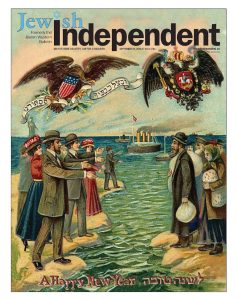In 1492, as schoolchildren used to learn, Columbus sailed the ocean blue. In Jewish history, as in the history of North American First Nations, 1492 stands out as a blue year for other reasons.
That year is remembered as the end of a golden age of Jewish civilization and multicultural amity in Iberia. The Jews of Spain (and, later in the same decade, the Jews of Portugal) were ordered to leave their homeland. In truth, the so-called golden age had ended for Jews more than 200 years earlier. The succeeding centuries had seen increasing levels of isolation, repression, exploitation, impoverishment, humiliation and violence, including notorious massacres in 1366 and 1391. Thousands of Jews had been forcibly converted, but even these “conversos” were not accepted as “true” Christians and were subject to pogroms perhaps as violent as any suffered by those who did not give up their Jewish ways. Spanish Jews were required to distinguish themselves by wearing a yellow badge. But, by 1492, it was determined that the proximity of conversos to their former co-religionists was causing recidivism. As in so many parallel instances, it was also no doubt a factor that Jews were evicted with few of their possessions, which were left to enrich the monarchs. And so the Jews were expelled, the departure slated for the day before Tisha b’Av.
In what appears to be a genuine effort at righting an historical wrong, the Spanish government announced recently plans to offer citizenship to Jews who can prove their Sephardi ancestry back to the expulsions. Lawyers in Israel and elsewhere are fielding calls by the score from people hoping to obtain Spanish citizenship, which, of course, also grants entry to the European Union as a whole.
The officials who are spearheading the drive to welcome back Spain’s Jewish descendants may believe that they are providing a permanent resolution, as best as can be done five centuries on, to a grave injustice. But perhaps they lack the breadth of knowledge of Jewish history to know the pattern into which their generosity falls.
Generation after generation, in duchies, principalities, city-states and empires throughout Europe, Jews in one generation would be exploited for economic advantage by the ruler then forced out when their economic usefulness was drained, only to be welcomed back when a new generation of leaders smelled economic advantage. Then, almost invariably, the cycle would begin again.
While this occurred in instances too many to count, yet in ways astonishingly alike each time, the expulsion from Spain stood out in Jewish history. Until the grievous experiences of 20th-century Europe, the expulsion from Spain was held up as the darkest example of the perils of Jewish statelessness since the destruction of the Temple.
There is little doubt that the current initiative by the Spanish government is being approached in a spirit of fraternity and justice. But it also has to be noted that the European economy overall, and those of southern European states like Spain in particular, are at their worst in a generation. It was precisely at times like these in history when a duke or prince would decide that it was an advantageous time to welcome back the Jews that his grandfather or great-grandfather had forced from the realm. The Jews of Europe, always seeking a place where they may find some peace and a welcome, would flow back in, experience a period of well-being followed inevitably by economic, political and religious oppression, followed by another expulsion.
Surely, this is not what the good legislators of Spain are thinking as they make this invitation. But Jewish people with a better sense of history can certainly be forgiven for seeing this act of generosity in a broader historical context.
 “The card depicts two eagles in the sky: under the Imperial Eagle of the Russian coat of arms, a group of impoverished, traditionally dressed Russian Jews, carrying their meagre belongings, line Europe’s shore, gazing with hope across the ocean,” wrote Neudorfer. “Waiting for them are their Americanized relatives, whose outstretched arms simultaneously beckon and welcome them to their new home. Above them, an American eagle clutches a banner with a line from Psalms: ‘Shelter us in the shadow of Your wings.’”
“The card depicts two eagles in the sky: under the Imperial Eagle of the Russian coat of arms, a group of impoverished, traditionally dressed Russian Jews, carrying their meagre belongings, line Europe’s shore, gazing with hope across the ocean,” wrote Neudorfer. “Waiting for them are their Americanized relatives, whose outstretched arms simultaneously beckon and welcome them to their new home. Above them, an American eagle clutches a banner with a line from Psalms: ‘Shelter us in the shadow of Your wings.’”